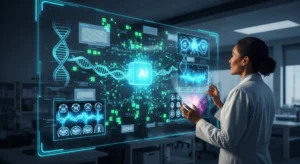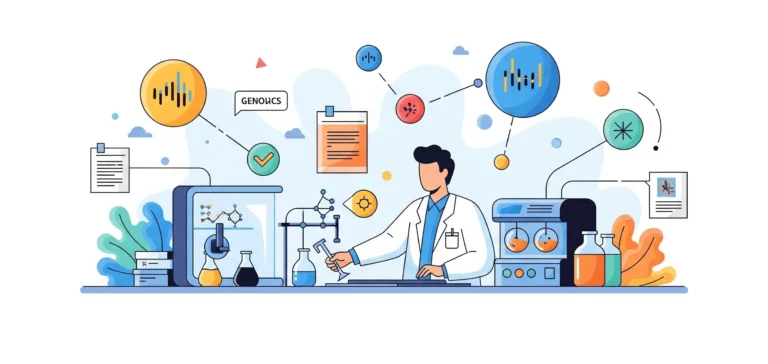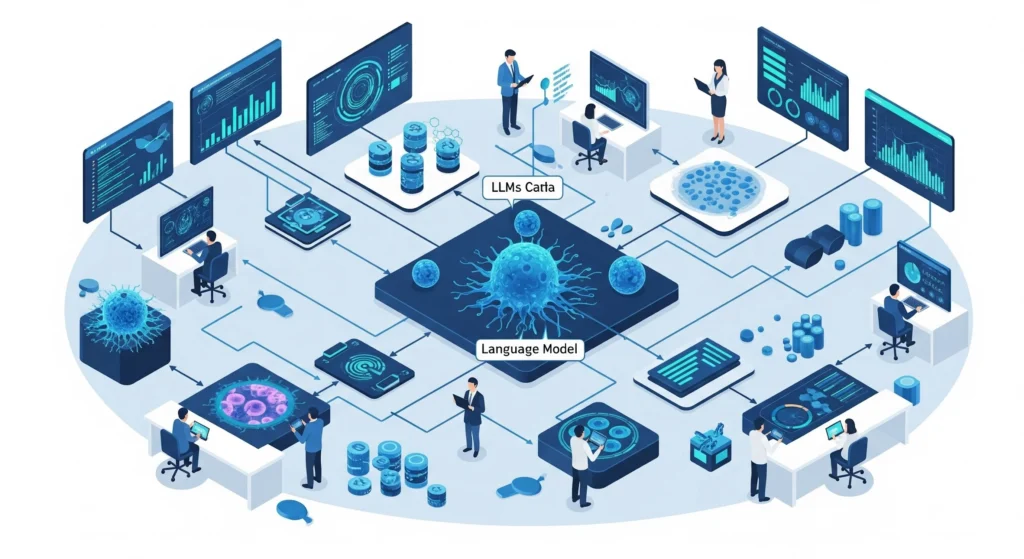
Setting the Stage: A Fictional Clinician Navigates a Data-Driven Era
This blog is based on a hypothetical story of Dr. Anaya Mehta—a fictional oncologist created to illustrate how Large Language Models (LLMs) are transforming cancer research and care. While Dr. Mehta herself is not real, the challenges she faces and the technologies she uses are grounded in real-world clinical practice and current AI research.
When oncologist Dr. Mehta first stepped into her hospital’s tumor board meeting, she was armed with high hopes—and a mountain of chaos. Patient records spanned dozens of PDFs. Genomic data lacked context. Trial eligibility forms were a jungle of medical jargon. As she juggled clinical judgment and research deadlines, one thing became clear: modern oncology was drowning in its data.
What changed her story? Large Language Models (LLMs)—the same kind of AI that powers tools like ChatGPT, but trained for biomedical use. This blog tells her story, and in doing so, explains how LLMs are reshaping cancer research and care.
Table of Contents
- Why Cancer Desperately Needs AI—Especially LLMs
- Why Cancer Desperately Needs AI—Especially LLMs
- How LLMs Are Already Changing Oncology
- Biomedical Literature Mining
- Clinical Trial Matching
- Radiology & Pathology Interpretation
- Patient-Facing Communication
- Technical Challenges
- Tools & Datasets for Cancer LLMs
- What’s Next: Precision Oncology 2.0
- Final Words: A New Era in Cancer Care with AI
Why Cancer Desperately Needs AI—Especially LLMs
Cancer isn’t one disease. It’s a genomic puzzle, a phenotypic chameleon, and a data deluge all rolled into one. Clinicians face enormous barriers:
- EHRs are packed with unstructured notes and inconsistent terminology
- Pathology and radiology reports written in shorthand or local vocabularies
- Sequencing data that’s difficult to interpret without cross-reference
- Scientific literature that grows faster than any human can read (PubMed adds ~1 article per minute)
Traditional tools can’t handle the semantic complexity of this ecosystem. That’s where LLMs come in: powerful models trained to understand and generate human-like biomedical language at scale.
That’s when Dr. Mehta discovered LLMs. “What if,” she thought, “I could train a model to read like a doctor, synthesize like a researcher, and communicate like a human?”
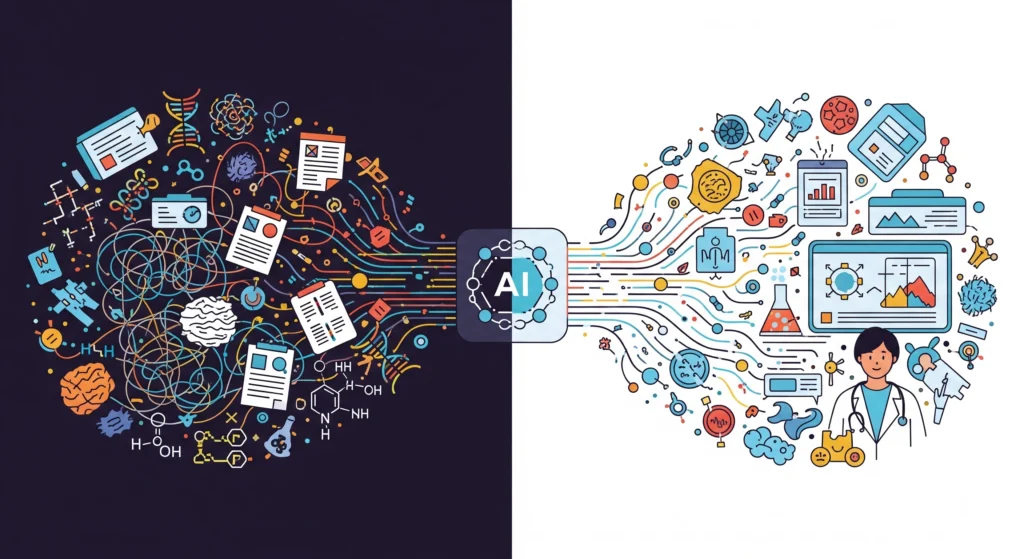
How LLMs Are Already Changing Oncology
Let’s break down how LLMs are delivering real clinical and research value.
1. Biomedical Literature Mining
LLMs like BioGPT and PubMedBERT are trained on millions of PubMed articles and biomedical corpora. They:
- Extract gene-drug-disease relationships
- Summarize the mechanisms of action.
- Suggest drug repurposing or hypothesis generation.
Dr. Mehta was exploring PD-1 resistance in melanoma. Instead of combing through 300+ papers, BioGPT returned key papers, summarized findings, and even identified novel gene associations missed by manual search.
2. Clinical Trial Matching
LLMs such as GatorTron and Med-PaLM help match patients to trials by:
- Parsing EHRs into structured phenotypes
- Understanding eligibility criteria in natural language
- Automating matching and ranking based on genomics and history
One of Dr. Mehta’s lung cancer patients was overlooked for a niche trial due to an uncommon mutation. GatorTron parsed their record and matched them within minutes.
3. Radiology & Pathology Interpretation
Reports often contain shorthand like “hyperintense lesion, non-specific.” LLMs trained on clinical text can:
- Normalize ambiguous or site-specific vocabulary
- Extract staging, tumor site, and treatment response details
- Convert free-text into structured summaries for downstream analytics.
A 2024 study from Stanford and UCSF evaluated GPT-4 on actual radiology reports related to pancreatic cancer. The model achieved an F1-score of over 75% in extracting structured oncology data, demonstrating that fine-tuned LLMs can accurately transform messy narrative reports into usable, standardized information for clinical workflows (Chen et al., 2024).
In a pilot with GPT-3 fine-tuning, Dr. Mehta’s team generated standardized oncology summaries from free-form MRI reports with 94% accuracy.
4. Patient-Facing Communication
Models like MedAlpaca and domain-specific ChatGPT variants can:
- Translate genomics into plain English
- Explain treatment options
- Empower shared decision-making
A patient struggling with BRCA terminology received a clear explanation: “This mutation increases your risk, but also tells us which treatments may work.” For Dr. Mehta, that moment of clarity and trust was invaluable.
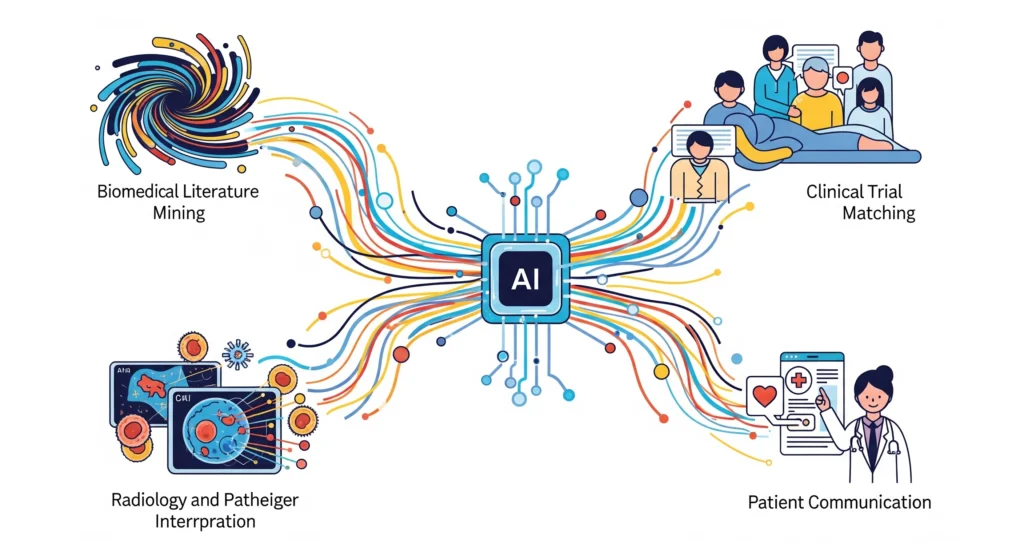
Technical Challenges
Despite the promise, LLMs in oncology still face hurdles:
- Hallucination: Confident but incorrect answers can be dangerous.
- Token limits: Clinical documents can be longer than most model capacities.
- Bias: Training data often underrepresents minorities or rare cancers.
- Privacy: Medical LLMs must be designed with HIPAA and GDPR compliance in mind.
Solutions under exploration:
- RAG (Retrieval-Augmented Generation) for grounded answers
- Differential privacy & federated learning for secure training
- Instruction tuning to ensure factual accuracy and task alignment
Dr. Mehta ran into problems with her first language model. One day, it wrongly described a harmless tumor as cancerous—something that could have serious consequences in real life. After that, her lab switched to using a method called Retrieval-Augmented Generation (RAG), which helps the model pull facts directly from trusted sources like PubMed. This way, every answer is backed by real scientific evidence (Lewis et al., 2020).
To keep patient data safe, they also used privacy-protecting techniques like differential privacy and federated learning, which let the model learn from medical data without exposing sensitive information (Abadi et al., 2016). And to make sure the model followed medical rules and gave more accurate answers, they used instruction tuning—basically teaching the model to respond in a way that fits the task and avoids confusion (Wei et al., 2022).
Tools & Datasets for Cancer LLMs
| Tool/Resource | Purpose |
| BioGPT | Biomedical generation & QA |
| PubMedBERT | Pretrained BERT on PubMed |
| GatorTron | Clinical LLM on 90B words |
| Med-PaLM | Medical QA by Google |
| MedAlpaca | Instruction-tuned medical ChatGPT |
| CancerLLM | Multi-modal oncology foundation model |
| OncoKB | Clinical oncology knowledge base |
| TCGA | Public cancer genomic data |
Dr. Mehta’s workflow integrates GatorTron for EHR parsing, CancerLLM for report summarization, and a custom PubMedBERT agent for literature Q&A. The stack may be complex, but it’s faster than any human team alone.
What’s Next: Precision Oncology 2.0
The next frontier lies in multimodal LLMs—those that understand text, genomic variants, radiology images, and more. These models could:
- Take a clinical note and a sequencing file
- Read pathology slides (via vision transformers)
- Recommend personalized therapies with literature-backed explanations.
Projects like CancerLLM and MultiMedBench are building LLMs that understand a full patient profile, not just text.
“In the near future,” Dr. Mehta says, “we could see a model that reads patient history, matches trial options, suggests treatments, and justifies decisions—all grounded in the latest science.”
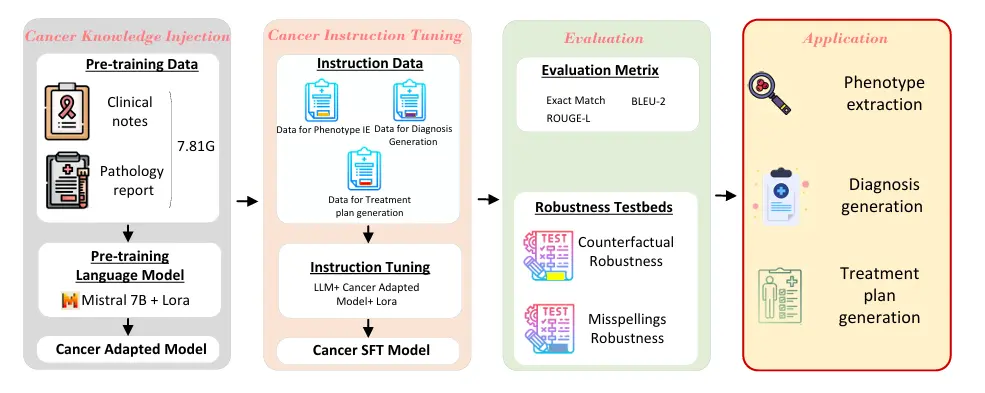
Final Words: A New Era in Cancer Care with AI
Large Language Models (LLMs) are no longer just experimental tools—they are becoming essential allies in cancer research and treatment. They help clinicians make sense of overwhelming medical data, reduce the time needed for diagnosis, improve the accuracy of insights, and support patients and doctors alike through clearer communication and faster decisions.
As data scientists, healthcare professionals, and AI engineers, we are at the frontier of something transformative. LLMs won’t replace oncologists—but they will amplify their capabilities, extend their reach, and speed up innovation in ways we’ve never seen before.
And Dr. Mehta’s story reminds us why this matters.
She didn’t walk away from the challenges of modern medicine—she adapted. After encountering the limits of traditional workflows, Dr. Mehta embraced AI not just as a tool but as a collaborator. By validating LLMs, working with developers, and deploying them carefully in clinical practice, she evolved into a hybrid professional: part doctor, part data translator.
As she often says, “Cancer won’t wait. If AI can save time, it can save lives.”
This isn’t just a vision of the future. It’s already happening.
And you—whether you’re building, researching, or treating—can be part of it.
Enhance Your AI & ML Skills
Struggling to understand concepts like machine learning, neural networks, or generative AI? Dive deeper into the world of AI with expert-led courses on CloudxLab — your gateway to mastering applied AI for the real world.
Visit CloudxLab
